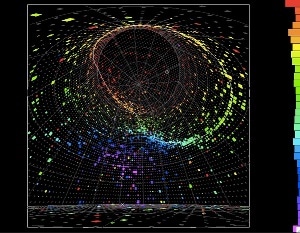Aug 7 2017
Neutrinos and antineutrinos are sometimes known as ‘ghost particles’ because they are difficult to detect and they can transform from one form to another. The international T2K Collaboration reveals a first sign that the dominance of matter over antimatter might originate from the fact that both neutrinos and antineutrinos behave differently during oscillations.
 n electron-neutrino interaction observed by the T2K experiment. The neutrino interacts with a water molecule in the detector volume producing an electron which in turn emits Cherenkov light while travelling across the detector. This light is collected by special photo-sensors and converted into a measurable electric signal. © Albert Einstein Center for Fundamental Physics (AEC), Laboratory for High Energy Physics, University of Bern
n electron-neutrino interaction observed by the T2K experiment. The neutrino interacts with a water molecule in the detector volume producing an electron which in turn emits Cherenkov light while travelling across the detector. This light is collected by special photo-sensors and converted into a measurable electric signal. © Albert Einstein Center for Fundamental Physics (AEC), Laboratory for High Energy Physics, University of Bern
This is a significant milestone towards the understanding of the Universe. A group of particle physicists from the University of Bern offered important contributions to this experiment.
The Universe is mainly made of matter and the obvious lack of antimatter in the Universe is one of the most interesting questions of modern science. In a colloquium held at the High Energy Accelerator Research Organization (KEK) in Tsukuba, Japan, the T2K collaboration, which includes Researchers from the University of Bern, announced that the symmetry between both matter and antimatter (called “CP-Symmetry”) is violated for neutrinos with 95% probability.
Different Transformation of Neutrinos and Antineutrinos
Neutrinos are elementary particles that pass through matter almost undisturbed. They appear in three different forms: tau, muon and electron neutrinos and their respective antiparticle (antineutrinos). T2K found a new kind of transformation among neutrinos in 2013 and showed that muon-neutrinos convert (oscillate) into electron-neutrinos while passing in space and time. The result of the recent T2K study rejects with 95% probability the theory that the analogous conversion from muon-antineutrinos to electron-antineutrinos occurs with identical chance. This is the first sign that the symmetry between both matter and antimatter is violated in neutrino oscillations and thus neutrinos play a role in the formation of the asymmetry of matter and antimatter in the universe.
“This result is among the most important findings in neutrino physics over the last years and it is opening the way to even more exciting achievements, pointing to the existence of a tiny but measurable effect. Nature seems to indicate that neutrinos can be responsible for the observed supremacy of matter over antimatter in the Universe. What we measured justifies our current efforts in preparing the next scientific enterprise, DUNE, the ultimate neutrino detector in USA, which should allow reaching a definitive discovery.
Prof. Antonio Ereditato, Director of the Laboratory of High Energy Physics, the University of Bern and Leader, the Bern T2K group
A remarkable contribution from the Bern group
In the T2K test, a muon-neutrino beam is generated at the Proton Accelerator Research Complex (J-PARC) in Tokai, on Japan’s east coast and is detected 295 kilometres away by the huge Super-Kamiokande underground detector (“T2K” represents “Tokai to Kamiokande”). The neutrino beam has to be completely characterized immediately after production, that is, before neutrinos begin to oscillate. For this purpose, the ND280 detector was made and installed near to the neutrino departing point.
Scientists from the University of Bern, along with collaborators from ETH Zurich and Geneva, and other international institutions, contributed to the design, implementation and operation of ND280. In particular, the team of Bern handled the huge magnet surrounding the detector and developed and operated the muon monitor, a device required to measure the intensity as well as the energy spectrum of the muon particles generated together with neutrinos. Currently, the Bern team is very active in determining the probability of neutrinos’ interaction with the ND280 apparatus: a vital ingredient to reach high-precision measurements like the one reported here.